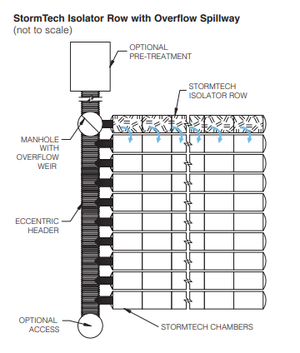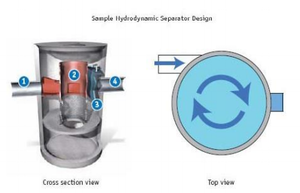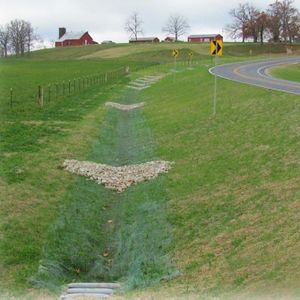
Difference between revisions of "Stormwater preatreatment selection information"
m |
m |
||
| Line 31: | Line 31: | ||
*[[Hydrodynamic separation devices - installation and maintenance recommendations]] | *[[Hydrodynamic separation devices - installation and maintenance recommendations]] | ||
| − | <font size=3>''' | + | |
| + | <font size=3>'''Summary information for hydrodynamic separation devices'''</font size><br> | ||
<table class="sortable"> | <table class="sortable"> | ||
<tr> | <tr> | ||
Revision as of 13:20, 25 June 2019
This page provides information for stormwater pretreatment practices discussed in this manual. It is divided into sections based on the type of device. Each section contains a table summarizing the characteristics for each pretreatment practice within a specific type of device.
- Hydrodynamic separation devices
- Screening and straining devices, including forebays
- Above ground and below grade storage and settling devices
- Filtration devices and practices
- Other pretreatment water quality devices and practices
Contents
Hydrodynamic separators
Hydrodynamic separators are flow-through, often proprietary structures that establish a high-speed rotating flow within a cylindrical chamber. Larger particles in the rotating stream have greater density than smaller particles to follow the tight curve of the stream, and thus strike the outside wall, falling to the bottom of the chamber where they can be later removed. While this means of settling does not always occur in this manner, generally the larger, more dense particles well settle to the bottom of these devices.
Some devices include other treatment and removal mechanisms such as the ability to trap floatables and/or provide a higher level of filtration or screening. These units are typically installed underground, frequently in existing sump manhole.
Hydrodynamic separation devices - system design
Many hydrodynamic separators are well-suited for use in or retrofitting existing manholes that service small to moderate-sized catchments (<5 acres). Devices are available in a variety of sizes and corresponding flow capacities. For some devices, the different models and corresponding dimensions can be accessed using the hyperlinks shown in this table.
System and Component Sizing
The sizing of a hydrodynamic separation system can be estimated using various tools, formulae, or guidance documents. Most manufacturers have a design tool or calculator for determining the size of device that may be needed; however modeled flow rates or the Rationale Method can be used to estimate the runoff flow rates. Additionally, guidance from the State of New Jersey Department of Environmental Protection and Washington State Department of Ecology provide additional considerations based on performance of these devices. In addition, SHSAM (Sizing Hydrodynamic Separators And Manholes) is a computer program for predicting the amount of suspended sediments removed from stormwater runoff by a given hydrodynamic separator/standard sump over a given period of time. SHSAM uses a continuous runoff model and sediment removal responses to predict the removal efficiency of the hydrodynamic separator device.
Most important for the sizing is the anticipated frequency of operation and maintenance as well as the protection of downstream BMPs and receiving water. Sizing is usually based on design flow rather than design flow. Most have configurations to bypass additional flow without resuspending solids. Some devices have “enhancements” that can provide other treatment mechanisms beyond pretreatment. These can provide an additional level of treatment such as filtration, skimming (in addition to settling or screening), chemical treatment/ sorption, or biodegradation. This is denoted table on system and component sizing.
Installation and Maintenance Recommendations
Proprietary hydrodynamic separators are generally designed to be easy to measure solids accumulation with access for maintenance from the street level. Manufactures often recommend more frequent inspections for a period after installation in order to gauge sediment and debris accumulation rates that may depend on factors such as nearby construction, winter or rainy conditions, street sanding, or a highly erosive drainage area. The information gained during this time is the primary indicator for how often inspections and cleanings may require to be scheduled. An initial estimate is usually available from the manufacturer. Manufacturers also have maintenance manuals or guides available, which can be accessed in the hyperlink within the table on maintenance recommendations. Generally, hydrodynamic separators are designed for quick and simple, but more frequent, maintenance than other practices. An advantage of hydrodynamic separators is that they are designed to minimize washout and sediment scouring within the system. In many locations, disposal of sediments removed may be handled in the same manner as disposal of sediments from catch basins (see here). Hydrodynamic separators generally are for areas without steep grading.
Links to tables with information on hydrodynamic devices
Below are links to several tables containing information on hydrodynamic separators. To see all tables on a single page, link here. To see the information in a single spreadsheet click on the following link: File:Hydronamic separation table all data.xlsx
- Hydrodynamic separation devices - pollutant removal characteristics
- Hydrodynamic separation devices - system design information
- Hydrodynamic separation devices - system and component sizing
- Hydrodynamic separation devices - installation and maintenance recommendations
Summary information for hydrodynamic separation devices
| Characteristic | Vortechs TM by Contech | Continuous Deflective Separation (CDS) R by Contech | Downstream Defender TM H.I.L. Technology | First Defense R by Hydro International | Stormceptor R by Imbrium or Rinker Materials | Barracuda by BaySaver | Dual Vortex Separator by OldCastle | SciClone TM by BioClean |
|---|---|---|---|---|---|---|---|---|
| Land use | Ultra-high density, Industrial, Commercial, "Hotspots" such as gas stations or high vehicular traffic areas | Ultra-high density, Industrial, Commercial, "Hotspots" such as gas stations or high vehicular traffic areas | Ultra-high density, Industrial, Commercial, "Hotspots" such as gas stations or high vehicular traffic areas | Ultra-high density, Industrial, Commercial, "Hotspots" such as gas stations or high vehicular traffic areas | Ultra-high density, Industrial, Commercial, "Hotspots" such as gas stations or high vehicular traffic areas | Ultra-high density, Industrial, Commercial, "Hotspots" such as gas stations or high vehicular traffic areas | ||
| Downstream BMP (type) | Filtration, Detention/Infiltration, Rainwater Harvesting | Filtration, Infiltration, Detention | Filtration, Infiltration, Detention, Wetland | Filtration, Infiltration, Detention | Filtration and Detention/Retention systems | Filtration, Infiltration, Detention | Infiltration, Detention, and Retention systems | Filtration, Infiltration, Detention |
| Mechanism enhancement | Yes | Yes | Yes | Yes | yes | No | Yes | Yes |
| Sizing calculations | Each system custom sized for site one of two ways: to provide a specific removal efficiency of a predefined particle size distribution, or by the Rational Rainfall Method. In most cases, pollutant removal goals can be met with a smaller system configured with an external bypass | Three primary methods of sizing system: the Water Quality Flow Rate Method to provide a specific removal efficiency of a predefined particle size distribution, the Rational Rainfall Method, or the Probabilistic Method when a specific removal efficiency of net annual sediment load is required | Q = ciA (runoff coeff. * intensity * area), then see (NJCAT) or refer to sizing calculator from manufacturer (does not require registration) or updated design tool (requires registration) | Q = ciA (runoff coeff. * intensity * area), then see Table 1 (NJCAT) or refer to updated design tool from manufacturer (requires registration) | PCSWMM for Stormceptor available from manufacturer for optimal design and sizing purposes (requires registration) | Volume based, treatment chamber capacity ranges from 212 gallons to 7496 gallons | See sizing and selection tool (does not require registration) | |
| Inlets | Perpendicular to vault to be tangential to grit chamber to induce swirling flow pattern | Grate inlet at street level and pipe inlet (may have multiple), inlet throat area sized to pass flow at surface elevation equal to crest of diversion weir, can be widened to increase capacity | Tangential to chamber | Grate inlet at street level and pipe inlet (may have multiple), max pipe diameter = 18-48 in | Varies by model | 12 in diameter, variable inlet/outlet angle configurations | Fits 1-3 inlets, see sizing and selection tool for max pipe sizes (does not require registration) | Single outlet |
| Outlets | Orientation determined for each system | Max pipe diameter = 18-48 in, Min dist from outlet invert to top of rim = 2-3.5 in to 3-6 in depending first on model then on pipe diameter | Varies by model | 12 in diameter, variable inlet/outlet angle configurations | Single outlet | |||
| Openings | Low flow control orifice sized to submerge inlet pipe when operating at 20%, High flow control weir sized to pass peak system capacity minus peak orifice flow | Diversion weir length and height dimensions determine hydraulic capacity of system | Varies by model | |||||
| Flow diversion structures | Baffle wall, circular grit chamber, flow control chamber, oil chamber | Diversion chamber, diversion weir, separation chamber, separation screen, oil baffle | Sloping base joined to a benching skirt at a 30-degree angle, dip plate | Built-in bypass, inlet chute | Insert slows water and directs it to lower chamber, non-turbulent treatment chamber with bypass insert | Weir prevents inflow from bypassing vortex separator, “teeth” reduce turbulence in sump area, inline may offer internal bypass | Incoming flow directed into parallel vortex tubes, isolated storage area with baffles | Flow splitter, sump chamber, outlet weir |
Screening and straining devices, including forebays
Screening and straining devices trap trash and coarse debris using smaller apertures such as grates or screens. While many pretreatment devices utilize screening and straining in tandem with their main treatment process, the examples in this category are constrained to those that primarily remove larger particles and sediment by screening or straining. These devices are often visible from ground level as they generally sit above grade or slightly below grade before or just following inlets in order to protect the downstream drainage system/BMP from clogging. This table contains both proprietary and nonproprietary devices, with the proprietary systems often applying the same or similar mechanisms to the nonproprietary systems but with convenient and sometimes easier construction or ease of maintenance.
System design
Screening and straining devices can often be installed in parallel to accommodate larger drainage areas, but in general, each unit is intended for a small drainage area (< 1acre).
System and component sizing
Most important for the sizing is the anticipated frequency of operation and maintenance as well as the considerations of how well the device provides protection of downstream BMPs and receiving waters.
Above ground and below grade storage and settling devices

Above ground and below grade storage and settling systems are typically below grade vaults, specialized structures, or similar practices that are designed to promote gravitational settling in a liquid-filled system. These devices may also be outfitted with additional structures to also trap trash, oil, and other floatables. The devices presented below are a mix of proprietary and nonproprietary systems. The proprietary entries are examples that utilize one or more of the nonproprietary functionalities.
Manholes with sumps have the space underneath the manhole’s lowest outlet (the sump) for sediment and debris collection and storage. The practice itself is nonproprietary, though proprietary outlet structures are available for enhanced performance.
Forebays are small bodies of water positioned just upstream of a larger pretreatment or treatment area. They slow the water allowing for settling of larger sediment. While these can be installed in front of vegetative filter strips, ponds, or other practices, each of which maintains its own specifications and recommendations, the forebays in this table are examples of the most common and general applications.
System Design
The underground settling vaults often come in pre-cast sizes from the manufacturer as an alternative to designing a custom unit. This is often a cost-effective approach with the designer selecting a larger size if manufacturer does not have the exact size based on calculations or sizing tables. Design and sizing tables may be available on a manufacturer’s website and are often accessible through the hyperlinks.
For forebays, the design is most often based on required capacity. Other specifications such as those listed under “Materials” often help to make maintenance easier.
System and Component Sizing
The sizing of an underground settling system can be estimated using various tools, formulae, or guidance documents. Most manufacturers have a tool or calculator for determining the size of device that may be needed, however modeled flow rates or the rational equation can be used to estimate the runoff flow rates. Additionally, guidance from the State of New Jersey Department of Environmental Protection and Washington State Department of Ecology provide additional considerations based on performance of these devices. Many sumped manholes can also use SHSAM (Sizing Hydrodynamic Separators And Manholes)44 for predicting the amount of suspended sediments removed from stormwater runoff over a given period of time. SHSAM is comprised of a continuous runoff model and sediment removal responses to predict the removal efficiency of the device. Most important for the sizing is the anticipated frequency of operation and maintenance as well as the protection of downstream BMPs and receiving waters.
Specifically regarding forebays, the capacity is determined by the flow received from its impervious drainage area. Then the shape of the basin and positioning of its inlets and outlets ensure that adequate settling occurs. Some devices have “enhancements” that can provide treatment mechanisms beyond the primary pretreatment mechanism. These can provide an additional level of treatment such as filtration, skimming (in addition to settling or screening), chemical treatment/sorption, or biodegradation. This is denoted by the Y or N in the table indicating this ability to perform additional mechanisms.
Filtration devices and practices
Filtration pretreatment practices include proprietary and non-proprietary devices that remove particles by filtration or sieving through media (gravel, sand or other), vegetation, geotextile or fabric material, metal or plastic screen, or other material. The filtration devices presented in this table are classified as pretreatment due to the nature of the filtration, placement in the treatment train, or built-in additional pretreatment mechanisms. The filtration methods are widely varied from biological to mechanical. They seek to remove not only larger sediments and debris, but also heavy metals, nutrients, and other fine contaminants. The natural or engineered biological systems are, by nature, above ground.
System Design
Some filtration pretreatment methods require a larger footprint than other pretreatment options due to the slower flow through rate and surface-area-based effectiveness. Most drainage area references refer to impervious area.
System and Component Sizing
Sizing is largely based on drainage area and estimated runoff volumes for different design storms or intensities. Most important for the sizing is the anticipated frequency of operation and maintenance as well as protection of downstream BMPs and receiving water. Some devices have “enhancements” that can provide treatment mechanisms beyond the primary pretreatment mechanism. These can provide an additional level of treatment such as filtration, skimming (in addition to settling or screening), chemical treatment/sorption, or biodegradation. This is denoted by the Y or N in the table indicating this ability to perform additional mechanisms.

